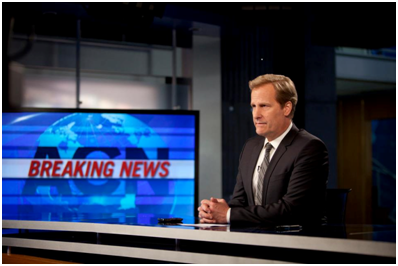May God save coincidence.
It is one of the most useful screenwriting tools. It means making two characters encounter each other at the right moment, creating a twist because something happens exactly when needed, or having your protagonist witness an event he needs to be aware of… All of the above can be done through coincidence.
However, it can also be a dangerous tool. Positive coincidence – fortuitous events or the use of random information – is risky. The audience could perceive coincidence for what it really is – a tool used by the writer to keep the story going – and their suspension of disbelieve would be… suspended.
Good screenwriters are aware of the problem and know techniques to make positive coincidence work.
Here is an example from the pilot episode of The Newsroom.
In the story, based on true events, the protagonists of the show are the first to understand that an oil spill in the Gulf of Mexico could become an environmental disaster. In the climax of the episode, anchorman Will McAvoy decides that, unlike other channels’ newscasts, he will focus on this story, not on the search for survivors.
Now, McAvoy’s choice comes from the fact that one of his journalists, even if not specialized in extraction of petroleum, happens to know people – two different sources, thus a great positive coincidence – who can give him substantial information on the subject. His inside knowledge is what convinces McAvoy to tell that specific story.
Answering Terry Gross’ questions during a Fresh Air episode on NPR, Aaron Sorkin says that he didn’t intend to give real journalists a lesson of good journalism (in the real events, the news of the environmental disaster came out after two days), and he also explains how to solve the problem of coincidence:
My intention in the pilot was not to say “gee, if only news people were smart as my guys, they would have figured this out of twenty minutes”. There was a remarkable coincidence that happened to one of my fictional characters that didn’t happen to anyone else [i.e. to any journalist during real events of the oil spill]. One of our characters, a brand new guy, had a college roommate who was an engineer from BP and a sister who worked for Hulliburton, both of whom were willing to whistle-blow within five minutes of each other. […] I shine a pretty big light on that. When you’re writing and you want to use something that is unlikely… Ok? The way to do that is to fly in the teeth of its unlikeness, ok? To not try to get away with it, but to shine a light on it. For instance, in the pilot we shine a light on that coincidence. Will, Jeff Daniels’ character, says: “You’re telling me you got not one but two sources to roll over on their employer within five minutes of each other?” John Gallagher’s character, Jim, says: “I know, I just got lucky”. And Will says: “How often do you get this lucky?” And John Gallager’s Jim says: “This is my first time”. In other words, we admit it is an unlikely coincidence.
If you watch the episode, you will notice that Will is eager to know who are Jim’s sources and has to ask a couple of times before receiving an answer. When the audience hears it with Will, they feel more satisfied in their curiosity than disturbed by the serendipity of the situation.
So, raise curiosity and fly in the teeth of unlikeliness.
That’s how Sorkin saved coincidence in The Newsroom pilot.


Be First to Comment